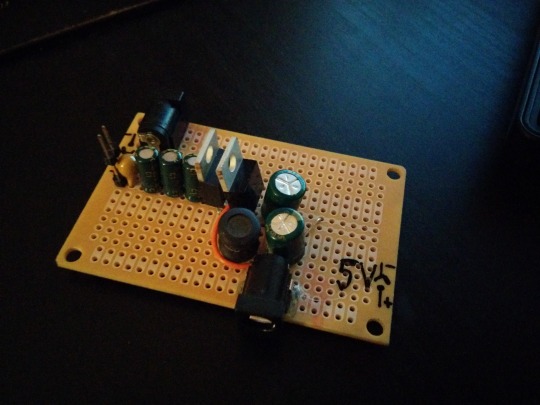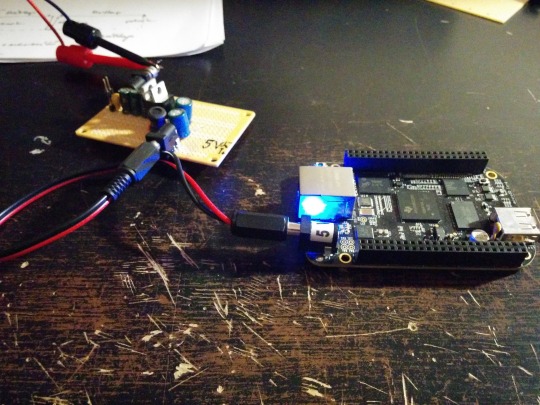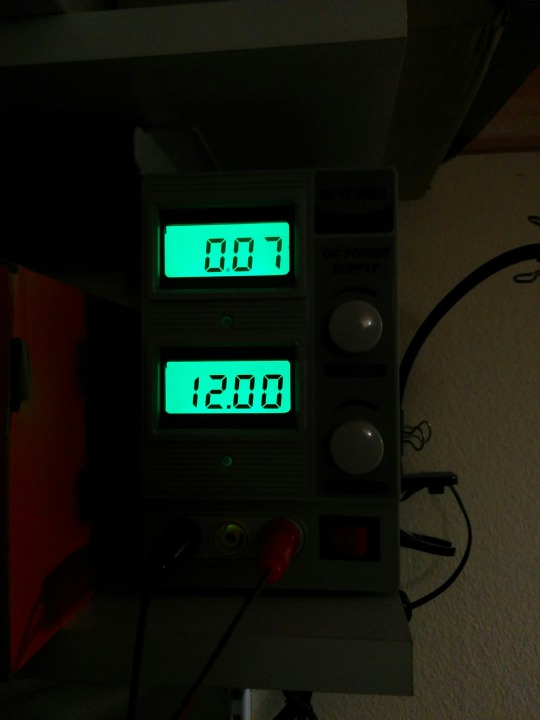Today I worked on the hardware stuff and I managed to build this circuit:

And the result is:

But what is this and why do we need it? Or, do we need it at all? Keep reading, and you will find the answers for all these questions!
Buck converters
In our future plans the layout will have some signaling lamps beside the tracks, and these signals need 12V to operate. But our chosen embedded systems, the BeagleBone Black cards need only 5V. Therefore, if we want only one power source which feeds all these devices, then we need to scale down
12V to 5V somehow.
Intermezzo: why would we use only one power source? It’s really simple: it makes the wiring simpler, there will be no more power sources and power lines, and the power loss on the wires will be no harm for us. Furthermore, it makes the future maintenance lot more easier.
With linear voltage regulators this would waste 7V on heat, and that means we will have efficiency of ~41%. Just waste of energy!
About 6 months earlier, I’ve started searching on Youtube for channels working with electronics, and I must admit that the whole idea came from this video:
So buck converters do a little magic trick: they get an input
voltage and they transform it up or down to higher or lower voltage –
with really high efficiency (about 90%). This is a very good news for us,
because that’s what we want and we can’t find a better solution for this purpose!
Some measurements – only for the hardcore readers
So, after I put the layout together I made some measurements. First, I connected the BeagleBone card to my power supply directly without any buck converters. That’s what I measured:

In this case it’s clear, that the output voltage is 4.99V and the card consums 310mA.
Then I added our new prototype as you can see in the following picture:

On the image you can see that the BeagleBone is connected to the output of the buck converter, and the buck converter is connected to the power supply by the black and red hook. Then I started to turn up the voltage on the power supply:

At 7,78V the current consumption is started to decrease…

And that’s what I am talking about! If we supply our card from 12V, it consumes only 70mA, only 22% of the original consumption!
Do the math (don’t hate me)
First, let’s Google the definition of Electric power:
The electric power in watts produced by an electric current I consisting of a charge of Q coulombs every t seconds passing through an electric potential (voltage) difference of V is:

Then some calculation:
- If consumption is 0.3A on 5V, our system will consume 0,3A*5V=1.5W power on each BeagleBone card.
- but, if it consumes only 0.07A on 12V, then the power consumption is 0.07A*12V=0.84W.
This is 45% more efficient than the other solution, and we just saved 0.66W power on each BeagleBone. That’s where I became so happy that I started to write this entry, so… the story ends here. Thanks for your attention, I hope you found this entry useful!
zsoltmazlo
